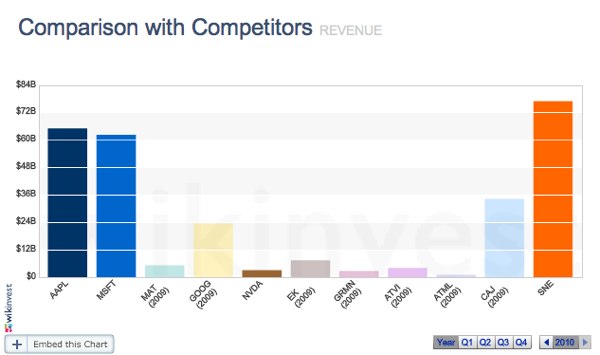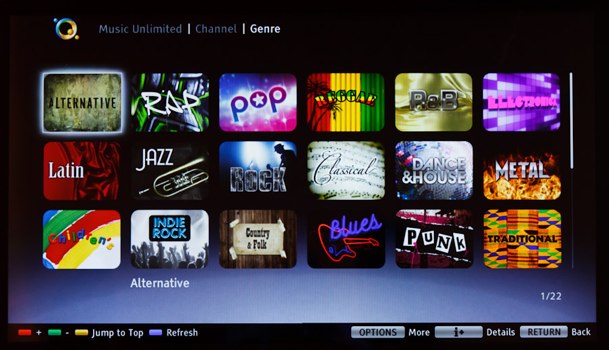Monster Builds - Technology, News, and More!
Google Custom Search
Followers
Wednesday, March 9, 2011
Monday, March 7, 2011
How Netflix is Destroying Blockbuster
In February 2010, the American Customer Satisfaction Index named Netflix the number one ecommerce company for customer satisfaction. Netflix has been named the number one retail Web site for customer satisfaction in 10 out of 11 surveys since 2005 by ForeSee Results. In the fall of 2005, Fast Company named Netflix the winner of its annual Customers First Award. In January 2007, Netflix was named the Retail Innovator of the Year by the National Retail Federation. In December 2007, Netflix was ranked the number one online retailer by Nielsen Online.
Saturday, February 26, 2011
The 7 Most Stupidly Overpowered Hunting Weapons
#7
.577 Tyrannosaur Rounds
The .577 Tyrannosaur round is, well, let's just say they don't name something "the T-Rex" because of its subtly engineered grace:
The one on the left is the T-Rex; the fourth is an ordinary shotgun round.
It's a bullet so large that you can't actually use it. Here's a clip of people trying to fire it.
So basically, the Tyrannosaur round is only for dipshits who need to overcompensate for something more than they need working arms to shield their faces from angry bears, or else it's for expert hunters who have become so jaded by their excessive prowess that they feel the need to handicap themselves. Possibly literally.
#6
Shadow Shield
The Shadow Shield is a new kind of blind -- a camouflaged shelter that allows hunters to get close enough to their targets to fire shots. But the Shadow Shield takes that concept a bit further, in that it is to game what the Predator's cloaking device was to Arnold Schwarzenegger:
What is that? Something nailed to the tree?
Oh, it's an invisible man with a gun. Really, dude? I'm a fucking deer.
#5
The Net Gun
We'll let the website text introduce you to the Super Talon Net Gun: "Need an alternative to darts? Get a net gun. Need to rescue a bird that got entangled? Grab a net gun. Have a pet that always thinks you're trying to play tag with it and darts every time you get close? Grab a net gun."
That's right: From hunting to humanitarian missions to just getting your dog to hate you, nothing does it better than a cartoonish net-firing hand-cannon. Don't worry -- it doesn't require any special licenses or permits to operate, because it's technically classified as a "tool" instead of a "firearm" -- and you will be too, once you deploy something out of a Batman villain's arsenal just to bag a squirrel. It comes with a hefty $900 price tag, but for the arch nemesis on a budget, you can always just build one yourself.
#4
Barnes Varmint Grenade
The Barnes Varmint Grenade isn't actually a grenade, just a precisely engineered hollow-point bullet. It comes in two sizes: Regular ...
And Insecure:
The Varmint Grenade was designed by Barnes using "military-grade technology" to ensure that larger animals can be killed without damaging their valuable pelts, because the bullets expand so rapidly on impact that they don't actually punch through the other side of a larger animal. Small entrance hole on one side, nonexistent exit hole on the other side, bag of nice soft fur filled with animal soup inside. We should mention at this point that hollow-point bullets were actually banned for use in war by the Hague Convention, which predated the Geneva Conventions, because of their "inhumanity" ... so it's a good thing you're not usin' 'em on humanity, ain't it?! Yee-haw! Let's commitin' war-crimes agin' opossums!
#3
The Gobbler Guillotine Wild Turkey Broadhead
We don't mean to come off as anti-hunting here. Our food has to come from somewhere; we know that. And if you approach it with the right attitude, hunting is certainly more respectable than buying your meat at the store. It's just that so much of this advanced hunting gear isn't "treating the exchange of life with humane reverence" as much as it is "dramatically over-murdering furry things because they frown when I talk about doing it to people." But now, finally, there's a product that bridges the two worlds of humane hunting and rampant sociopathy! The Gobbler Guillotine is exactly what the name suggests: a specially designed arrowhead, engineered to instantly behead turkeys.
#2
The Internet
There's only one thing wrong with hunting: the outdoors. The killing's great, the free meat is great, the sense of undeserved confidence that comes with wielding a gun is fucking fantastic -- but all that fresh air and nature is a load of crap, isn't it? Well, don't worry. Just like every other terrible, morally bankrupt and probably illegal desire you have, the /internet has got your back on this one:
N
o, we should probably add another gun. These are rabbits we're talking about here; they're wily.
o, we should probably add another gun. These are rabbits we're talking about here; they're wily.
That thing is pretty much exactly what it looks like: A jury-rigged remote controlled gun platform hooked up to the Internet. This particular example had only three shotguns, but there were other platforms found in the area with upwards of six shotguns. You know, just in case you want to give that beaver the full "revolutionary firing squad" experience. Forty states have outright banned Internet hunting, but that doesn't stop people like Jay Williams, who created the above rig. He claims he set them up as hog control, but unless they're the hogs from Animal Farm, nobody's buying it.
#1
The Punt Gun
Are you ready? Are your sweaty fingers poised above the keyboard, your keen -- albeit somewhat myopic and beady -- eyes ready to spot the pixels? Here we go:
"FAAKE! PHOTOSHOPPZZZZ!!!!"
Nope, that's real, and it's not a mock-up or a model. Those are called punt guns, and they range from 6 1/2 up to roughly 10 feet in length. They're basically just giant shotguns that fire a pound of shot with every trigger pull. Here's a video of one in action, as narrated by Tony the Tiger:
Two things just happened in that video: One, somebody got a great sound clip for his animated 80s mascot snuff film, and two, that fucking gun just destroyed 50 targets and the entire table they were mounted on. So what was it used for, repelling bear armies? Assassinating continents? Mugging the moon?
Friday, February 18, 2011
Sony's 4-Step Plan To Destroy Apple
Step 1: Mimic Apple
Interestingly enough, the first step is tried and true for anyone learning to do something well: learn from the best. Apple is currently raking in $60 billion in revenue last year, but Sony pulled in an impressive $77 billion in revenue during the same time. And while Apple is, quite clearly, doing something right, Sony stands tall on its own. But numbers can be deceiving. Apple has everything going their way, and it is only a matter of time before Sony feels the hurt.But if Sony takes a few pages from Apple’s playbook, we could be telling a different story in the future.
Step 2: Consolidate
The second step is to consolidate Sony’s current products and platforms. If Sony reduces its efforts to producing only a handful — here is the “less is more” argument — of smart phones, tablets, and netbooks while combining its content platforms into one unified system, the company would be in a much better position to compete with Apple.Sony should begin by combining Music Unlimited, Qriosity, PlayStation Store, Reader Store, and any other content platforms that the company has into a unified platform like iTunes (Sony has already combined Music Unlimited and Qriosity, to their credit). Apart from providing developers and content providers a centralized location to deal with and directing consumers to a single platform to make all their purchases from, this would give Sony a single platform from which to base all of their hardware on. This is a very important step, and one that I have also criticized Microsoft about in the past.
Step 3: Cripple Apple
The third step might not be as difficult as it would appear. It starts off relatively simple: Sony would withdraw all of its content from the Apple ecosystem. This means that all of Sony’s artists that are signed to the company’s labels and all of Sony’s film and television content would no longer be available for purchase from within Apple’s iTunes marketplace.If we entertain the idea that Sony would actually pull its content (and Sony’s COO sounded very confident that this could happen in time), this act alone isn’t what would devastate Apple. It only becomes a powerful statement if the remaining trio of the “Big Four” music labels and the rest of the “Big Six” movie studios stand with Sony. Apple would then have a situation on its hands.
Step 4: Win Developers' Interest
Speaking of developers, this is the last step for Sony to reach the pinnacle of tech stardom. Without the support of third-party developers, all of the actions taken by Sony would not matter, because Apple (or Google, Research In Motion, Microsoft, etc.) would still have the most important piece of the pie — the creativity and innovation from the outside world.Friday, February 11, 2011
Cursing Aloud Helps People Tolerate Pain More than Not Cursing
This is so fucking cool (hey, we're just increasing our pain tolerance). Makes you wonder what it is about those words? Screaming "fiddlesticks!" at the top of your lungs won't produce the same effect, so it can't simply be the yelling... regardless, this myth isn't just a convenient excuse for the use of "colorful metaphors," it's backed up by the experimental data. And you have to admire the clever apparatus they designed so the viewers wouldn't be scandalized by watching Kari's lovely mouth form "naughty words". So, we've so far shown the values of physical violence AND obscene language -- who says this website isn't informative!
Thursday, February 10, 2011
4Chan Turns in Teen For Planning School Massacre
4Chan has landed itself in the middle of yet another FBI investigation. This time, though, the site is cooperating with authorities after a Michigan-based member named Ali Saad posted threats to go on a shooting rampage at his community college. Saad insists that his postings were in jest, but his claims that he could top the "high score" of Virginia Tech shooter Seung-Hui Cho set off alarms with members of the /b/ community. In one of the messages, Saad said that he planned to stream his massacre on Stickam, a popular video streaming site. Members of 4Chan alerted the FBI and the site turned over records of Saad's access. The FBI raided his home in Dearborn in late November and confiscated his computers, on which they found some child pornography. The student is now facing a pair of felony charges for posting the threats and for downloading child porn.
While Saad claims he was not serious about turning an AK-47 on of his lecture classes, investigators found evidence that he had extensively researched past shootings like that at Columbine and Virginia Tech. While it's impossible to know if Saad actually planned to kill his fellow students, we can safely say that even joking about such a thing is a terrible idea. Add that to the unavoidable child pornography charges, and we'd say Saad may be looking at a hefty jail sentence when his trial commences on February 25th.
Tuesday, February 8, 2011
Bing Caught Copying Search Results From Google
Google has run a sting operation that it says proves Bing has been watching what people search for on Google, the sites they select from Google’s results, then uses that information to improve Bing’s own search listings. Bing doesn’t deny this.
As a result of the apparent monitoring, Bing’s relevancy is potentially improving (or getting worse) on the back of Google’s own work. Google likens it to the digital equivalent of Bing leaning over during an exam and copying off of Google’s test.
“I’ve spent my career in pursuit of a good search engine,” says Amit Singhal, a Google Fellow who oversees the search engine’s ranking algorithm. “I’ve got no problem with a competitor developing an innovative algorithm. But copying is not innovation, in my book.”
Bing doesn’t deny Google’s claim. Indeed, the statement that Stefan Weitz, director of Microsoft’s Bing search engine, emailed me yesterday as I worked on this article seems to confirm the allegation:
As you might imagine, we use multiple signals and approaches when we think about ranking, but like the rest of the players in this industry, we’re not going to go deep and detailed in how we do it. Clearly, the overarching goal is to do a better job determining the intent of the search, so we can guess at the best and most relevant answer to a given query.
Opt-in programs like the [Bing] toolbar help us with clickstream data, one of many input signals we and other search engines use to help rank sites. This “Google experiment” seems like a hack to confuse and manipulate some of these signals.
More red flags went up in October 2010, when Google told me it noticed a marked rise in two key competitive metrics. Across a wide range of searches, Bing was showing a much greater overlap with Google’s top 10 results than in preceding months. In addition, there was an increase in the percentage of times both Google and Bing listed exactly the same page in the number one spot.
By no means did Bing have exactly the same search results as Google. There were plenty of queries where the listings had major differences. However, the increases were indicative that Bing had made some change to its search algorithm which was causing its results to be more Google-like.
Now Google began to strongly suspect that Bing might be somehow copying its results, in particular by watching what people were searching for at Google. There didn’t seem to be any other way it could be coming up with such similar matches to Google, especially in cases where spelling corrections were happening.
Google thought Microsoft’s Internet Explorer browser was part of the equation. Somehow, IE users might have been sending back data of what they were doing on Google to Bing. In particular, Google told me it suspected either the Suggested Sites feature in IE or the Bing toolbar might be doing this.
Is It Illegal?
Suffice to say, Google’s pretty unhappy with the whole situation, which does raise a number of issues. For one, is what Bing seems to be doing illegal? Singhal was “hesitant” to say that since Google technically hasn’t lost anything. It still has its own results, even if it feels Bing is mimicking them.Is it Cheating?
If it’s not illegal, is what Bing may be doing unfair, somehow cheating at the search game?On the one hand, you could say it’s incredibly clever. Why not mine what people are selecting as the top results on Google as a signal? It’s kind of smart. Indeed, I’m pretty sure we’ve had various small services in the past that have offered for people to bookmark their top choices from various search engines.
Google doesn’t see it as clever.
In the end, I’ve got some sympathy for Google’s view that Bing is doing something it shouldn’t.
Subscribe to:
Posts (Atom)



















